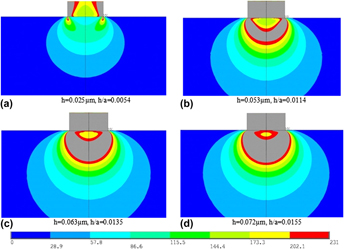Crossref Citations
This article has been cited by the following publications. This list is generated based on data provided by
Crossref.
Miguel, F.L.
Müller, R.
Mathur, S.
and
Mücklich, F.
2015.
Microstructure and mechanical properties of electrodeposited Ni and Ni–matrix-nanocomposite thin films.
Materials Science and Engineering: A,
Vol. 646,
Issue. ,
p.
254.
Midawi, A.R.H.
Simha, C.H.M.
and
Gerlich, A.P.
2016.
Novel techniques for estimating yield strength from loads measured using nearly-flat instrumented indenters.
Materials Science and Engineering: A,
Vol. 675,
Issue. ,
p.
449.
Hu, Zhong
Shrestha, Maheshwar
and
Fan, Qi Hua
2016.
Nanomechanical characterization of porous anodic aluminum oxide films by nanoindentation.
Thin Solid Films,
Vol. 598,
Issue. ,
p.
131.
Hu, Zhong
2017.
Microscopy Methods in Nanomaterials Characterization.
p.
165.
Shahjahan, Naureen B.
and
Hu, Zhong
2017.
Effects of angular misalignment on material property characterization by nanoindentation with a cylindrical flat-tip indenter.
Journal of Materials Research,
Vol. 32,
Issue. 8,
p.
1456.
Ochoa Brezmes, Angel
Reuther, Georg
Gneupel, Andreas
and
Breitkopf, Cornelia
2017.
Characterization of critical conditions for fracture during wafer testing by FEM and experiments.
Materials Science in Semiconductor Processing,
Vol. 67,
Issue. ,
p.
124.
Midawi, A.R.H.
Simha, C.H.M.
Gesing, M.A.
and
Gerlich, A.P.
2017.
Elastic-plastic property evaluation using a nearly flat instrumented indenter.
International Journal of Solids and Structures,
Vol. 104-105,
Issue. ,
p.
81.
Huang, Cong
Zhang, Pingze
Wei, Dongbo
Wei, Xiangfei
Chen, Xiaohu
and
Ding, Feng
2017.
Tribological behaviour of double-glow plasma zirconium-yttrium alloying on γ-TiAl.
Surface Engineering,
Vol. 33,
Issue. 12,
p.
911.
Liu, Ming
Zhu, Guangyu
Dong, Xiangyu
Liao, Jinming
and
Gao, Chenghui
2018.
Advanced Mechanical Science and Technology for the Industrial Revolution 4.0.
p.
271.
Riaz, Muhammad Qasim
Caputo, Matt
Ferraro, Mercedes M.
and
Ryu, Jae Joong
2018.
Influence of Process-Induced Anisotropy and Synovial Environment on Wear of EBM Built Ti6Al4V Joint Implants.
Journal of Materials Engineering and Performance,
Vol. 27,
Issue. 7,
p.
3460.
Ewane, Mireille Sandrine
Silvestri, Vincenzo
and
James, Michael
2018.
Indentation of a Sensitive Clay by a Flat-Ended Axisymmetrical Punch.
Geotechnical and Geological Engineering,
Vol. 36,
Issue. 6,
p.
3601.
Ryu, Jae
Shrestha, Sanjay
Manogharan, Guha
and
Jung, Jai
2018.
Sliding Contact Wear Damage of EBM built Ti6Al4V: Influence of Process Induced Anisotropic Microstructure.
Metals,
Vol. 8,
Issue. 2,
p.
131.
Seyedzavvar, Mirsadegh
and
Seyedzavvar, Mirali
2018.
Design of high duty diesel engine connecting rod based on finite element analysis.
Journal of the Brazilian Society of Mechanical Sciences and Engineering,
Vol. 40,
Issue. 2,
Ochoa Brezmes, Angel
and
Breitkopf, Cornelia
2018.
Influence of indenter tip diameter and film thickness on flat indentations into elastic-plastic films by means of the finite element method.
Thin Solid Films,
Vol. 653,
Issue. ,
p.
49.
Hu, Zhong
and
Hassan, Md Mehadi
2019.
Effect of Poisson’s ratio on material property characterization by nanoindentation with a cylindrical flat-tip indenter.
Journal of Materials Research,
Vol. 34,
Issue. 14,
p.
2482.
Chen, Hui
and
Cai, Li-xun
2019.
A universal elastic-plastic model correlating load-displacement relation and constitutive parameters for typical testing components.
Results in Physics,
Vol. 13,
Issue. ,
p.
102230.
Alaboodi, Abdulaziz S.
and
Hussain, Zahid
2019.
Finite element modeling of nano-indentation technique to characterize thin film coatings.
Journal of King Saud University - Engineering Sciences,
Vol. 31,
Issue. 1,
p.
61.
Chuah, Hun Guan
Tan, Wei Hong
Chang, Boon Peng
Khoo, Teng Seang
Khor, Chu Yee
and
How, Heoy Geok
2019.
The influence of surface roughness on material dislocation of microindentation using bonded interface technique.
Tribology - Materials, Surfaces & Interfaces,
Vol. 13,
Issue. 4,
p.
191.
Gao, Chenghui
Yao, Ligang
Zheng, Rongye
and
Liu, Ming
2019.
Effect of Sample Tilt on Spherical Indentation of an Elastic Solid.
Journal of Testing and Evaluation,
Vol. 47,
Issue. 4,
p.
2596.
Midawi, A. R. H.
Huda, N.
Simha, C. H. M.
and
Gerlich, A. P.
2020.
Characterization of Anisotropy of Strength in API-X80 Line Pipe Welds Through Instrumented Indentation.
Metallography, Microstructure, and Analysis,
Vol. 9,
Issue. 6,
p.
884.
